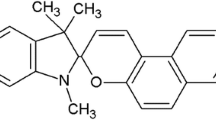Abstract
We report the in situ measurements of the sublimation rate and activation energy of continuous nanofilms of 2,4,6-trinitrotoluene (TNT) in air using UV absorbance spectroscopy. The films were prepared using acetone-dissolved TNT by simple spin coating deposition technique. Unlike traditional mass loss techniques, this new method is independent of the surface area of the sample which contributes to errors in determining physical parameters accurately in both bulk and thin films of materials. The calculated activation energy and temperature-dependent sublimation rates agree well with the reported values for TNT thin films. The results suggest that UV absorbance spectroscopy is an efficient tool in measuring thermodynamic properties in the nanometer scale for materials with absorbance in the UV region of the electromagnetic spectrum.




Similar content being viewed by others
References
Czarnecki J, Sestak J. Practical thermogravimetry. J Therm Anal Calorim. 2000;60:759–78.
Hajimirsadeghis SS, Teimouri MR, Rahimi-Nasrabadi M, Dehghanpour S. Non-isothermal kinetic study of the thermal decomposition of N-{bis[benzyl(methyl)amino]phosphoryl}-2,2-dichloroacetamide and N-{bis[dibenzylamino]phosphoryl}-2,2-dichloroacetamide. J Therm Anal Calorim. 2009;98:463–8.
Hobbs ML, Nakos JT, Brady PD. Response of a glass/phenolic composite to high temperatures. J Therm Anal Calorim. 2011;103:543–53.
Gershanik AP, Zeiri Y. Sublimation rate of TNT microcrystals in air. J Phys Chem A. 2010;114:12403–10.
Mu R, Ueda A, Liu YC, Wu M, Henderson DO, Lareau RT, Chamberlain RT. Effects of interfacial interaction potential on the sublimation rates of TNT films on a silica surface examined by QCM and AFM techniques. Surf Sci. 2003;530:L293–6.
Pitchimani R, Burnham AK, Weeks BL. Quantitative thermodynamic analysis of sublimation rates using an atomic force microscope. J Phys Chem B. 2007;11:9182–5.
Burnham AK, Qiu SR, Pitchimani R, Weeks BL. Comparison of kinetic parameters of single crystal pentaerythritol tetranitrate using atomic force microscopy and thermogravimetric analysis: implications on coarsening mechanisms. J Appl Phys. 2009;105:104312.
Ingle JDJ, Crouch SR. Spectrochemical analysis. New Jersey: Prentice Hall; 1988.
Schubert EF. Light-emitting diodes. 2nd ed. Cambridge: Cambridge University Press; 2006.
Hikal WM, Harmon HJ. Early events in 2,4,6-trinitrotoluene (TNT) degradation by porphyrins: binding of TNT to porphyrin by hydrophobic and hydrogen bonds. J Hazard Mater. 2008;154:826–31.
Hummel RE, Fuller AM, Schöllhorn C, Holloway CPH. Detection of explosive materials by differential reflection spectroscopy. Appl Phys Lett. 2006;88:231903.
Phelan JM, Patton RT. Sublimation rates of explosive materials-method development and initial results, Sandia report SAND2004-4525, Sandia national laboratories: Albuquerque, 2004.
Zeman S. Analysis and prediction of the Arrhenius parameters of low-temperature thermolysis of nitramines by means of the 15 N NMR spectroscopy. Thermochim Acta. 1999;333:121–9.
Pella PE. Measurement of the vapor pressures of TNT, 2,4-DNT, 2,6-DNT, and EGDN. J Chem Thermodynam. 1977;9:301–5.
Leggett DC. Vapor pressure of 2,4,6-trinitrotoluene by a gas chromatographic headspace technique. J Chromatogr. 1977;133:83–90.
Cundall RB, Palmer TF, Wood CEC. Vapour pressure measurements on some organic high explosives. J Chem Soc Faraday Trans1. 1978;74:1339–45.
Oxley JC, Smith JL, Shinde K, Moran J. Determination of the vapor density of triacetone triperoxide (TATP) using a gas chromatography headspace technique. Propell Explos Pyrot. 2005;30:127–30.
Lenchitz C, Velicky RW. Vapor pressure and heat of sublimation of three nitrotoluenes. J Chem Eng Data. 1970;15:401–3.
Edwards GT. The vapor pressure of 2,4,6-trinitrotoluene. Trans Faraday Soc. 1950;46:423.
Acknowledgements
This study was supported by NSF career (CBET-0644832).
Author information
Authors and Affiliations
Corresponding author
Rights and permissions
About this article
Cite this article
Hikal, W.M., Weeks, B.L. Determination of sublimation rate of 2,4,6-trinitrotoluene (TNT) nano thin films using UV-absorbance spectroscopy. J Therm Anal Calorim 110, 955–960 (2012). https://doi.org/10.1007/s10973-011-1888-8
Received:
Accepted:
Published:
Issue Date:
DOI: https://doi.org/10.1007/s10973-011-1888-8




